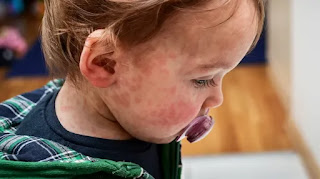Food Allergy Symptoms
When a person has a food allergy, their immune system responds to specific food proteins as if they were dangerous pathogens like bacteria, parasites, or viruses.
An immune system reaction known as a food allergy happens quickly after consuming a particular meal.
A very small amount of food that causes allergies can cause signs and symptoms like stomach issues, rashes, or enlarged airways.
Some people may experience severe symptoms from a food allergy, including the potentially fatal anaphylactic reaction.
According to estimates, up to 4% of adults and 8% of children under the age of five suffer from food allergies. Although there is no treatment, some kids outgrow their food allergies as they age.
It is simple to mix up a food allergy with food intolerance, a much more typical reaction.
Food intolerance is a less dangerous condition that does not involve the immune system while being irritating.
Food allergies typically start in childhood and, with some exceptions, children outgrow them. Although it is less common, food allergies can also manifest in maturity.
The causes, symptoms, triggers, and treatments of food allergies will all be discussed in this article.
Food Allergy and Symptoms
- Itchy mouth and throat
- Watery eyes
- Hives-like skin rash with facial puffiness
- Burning feeling in the lips and mouth
- Breathing difficulties
- Nausea
- Vomiting
- Diarrhea
- Runny nose
Common Cause of Food Allergies
- Soybeans
- Fish
- Milk
- Nuts from trees(hazelnuts, walnuts, cashews, and pistachios)
- Peanuts or groundnuts
- Eggs
- Shellfish, including shrimps, lobster, and crab
- Wheat
Food Allergy Treatments
It entails exposing the person to allergens in increasing doses.
Cooking surfaces, chopping boards, cutlery, and tableware may also need to be free of every trace of allergen.
Being cautious can be particularly challenging when dining out.
Medication for Urgent Allergy Situations
In the event of an allergic reaction, the following drugs are beneficial:
➡ Antihistamines
These are available as tablets, liquids, or gels. For persons with mild to severe food allergy symptoms.
They are typically beneficial. Histamines, which antihistamines work to suppress bring most allergy symptoms on.
➡ Epinephrine (Adrenaline)
This therapy is intended for people with food allergies who risk developing anaphylaxis.
By tightening blood arteries, epinephrine raises blood pressure. Furthermore, it eases the airways.
An epinephrine auto-injector, such as an EpiPen, EpiPen Jr., Twinject, or Auvi-Q, should always be kept on hand for people who have experienced severe allergic responses.
READ ALSO:
Frequently Asked Questions
1. How Long Does a Food Allergy Take to Show Symptoms?
A breathing or swallowing difficulty must accompany allergic reactions that are life-threatening.
This condition is known as anaphylaxis in medicine. Most of these reactions begin abruptly within 10 to 20 minutes.
All take place within two hours of consuming a specific food.
2. How Long do Food Allergy Symptoms Last?
Typically, symptoms appear as quickly as a few minutes or as late as two hours after ingesting a dish.
Sometimes, one to four hours after the initial symptoms subside, a second wave of symptoms appears (or sometimes even longer).
Biphasic reaction is the name given to this second wave.
3. How Do You Flush Allergens out Of Your System?
Maintain your fluid intake. The greatest thing you can do, according to Zeitlin, is to drink lots of fluids.
While your body is removing the allergen food from its system. You should always drink water.
but Zeitlin advises you should also sip on low-calorie sports drinks to replace any electrolytes you may be losing.
4. Why am I Suddenly Getting Food Allergies?
It's possible that you recently moved and are now exposed to new allergens, which set off your immune system.
A bacterial or viral illness may also turn that switch. Hormones can also act as a trigger, particularly in women.
Food allergies frequently appear during adolescence, pregnancy, or menopause.
5. What Happens if You Keep Eating Food You're Intolerant to?
Food intolerances affect your digestive system. Some foods are indigestible for those with intolerances or sensitivities.
They experience difficulties, like flatulence and diarrhea.
Food sensitivity or intolerance is uncomfortable but not life-threatening.
Asking your doctor for a professional diagnosis of a food allergy is crucial. If you suspect that you or your kid may be affected. If necessary, they can then direct you to an allergy clinic.
When a kid's symptoms are caused by something entirely different from a food allergy. Many parents incorrectly believe that their child has a food allergy.
There are commercial allergy testing kits available, however, it is not advisable to use them.
They construct many kits on dubious scientific theories. Even if they are accurate, you ought to have a doctor review to the findings.
We hope this was a great read. Let us know your thoughts and suggestions in the comment. Feel free to share with loved ones and active media accounts.







